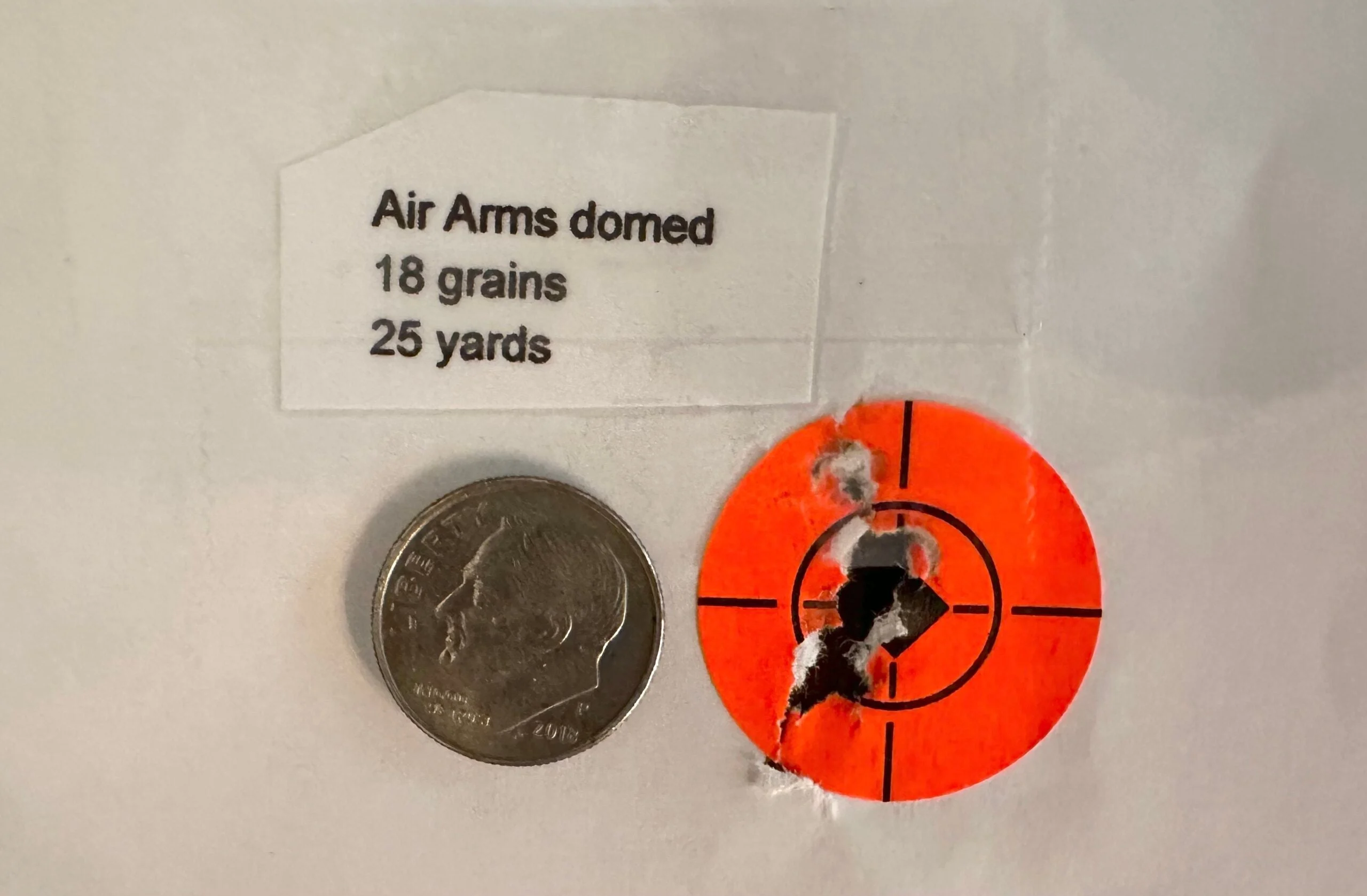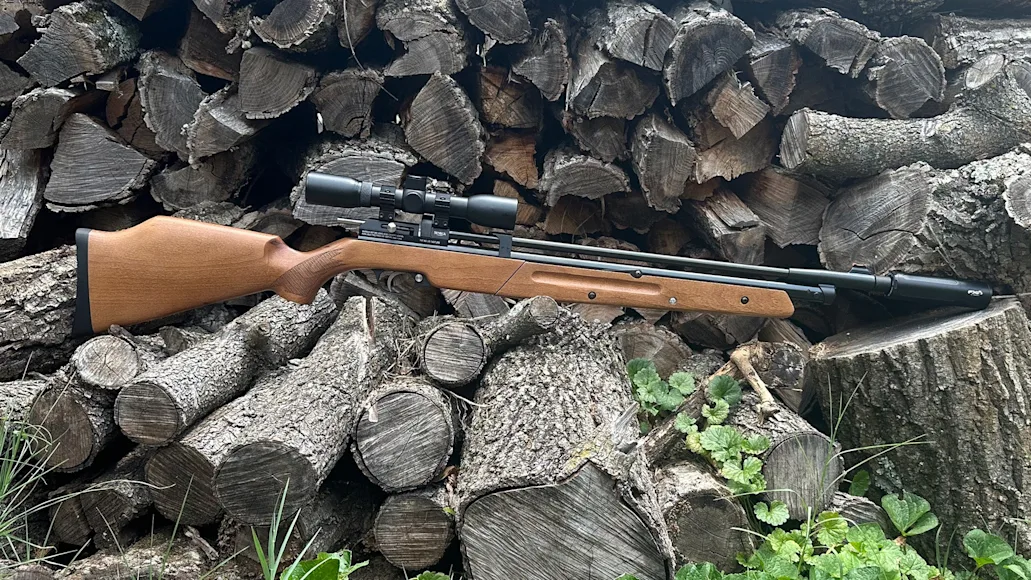_We may earn revenue from the products available on this page and participate in affiliate programs. Learn more ›
_
Even as airgun technology evolves, several companies continue to produce guns that use multi-pump pneumatic power plants. They are flexible, reliable, self-contained, quiet, and relatively affordable. The Seneca Dragonfly MK2
is a rifle that combines tried-and-true multi-pump technology with innovative features that take its convenience and performance to the next level.
First and foremost, the rifle offers a rotary magazine, eliminating the need to load a pellet by hand before each shot. Then there’s the gun’s pumping mechanism, which utilizes a unique “butterfly” multi-link design to keep pumping effort relatively consistent even as the air chamber fills. I’ve been shooting the Dragonfly MK2 for the past few months while noting its accuracy, groupings, features, handling, and overall performance. Here are my thoughts:
Seneca Dragonfly MK2 Overview
Specs
Type: Multi-pump pneumatic
Action: Bolt with rotary magazine or single-shot tray
Caliber: .22 (tested); .177
Projectile type: Pellets, slugs
Minimum pumps: 3
Maximum pumps: 15
Max feet per second (lead pellets): 850 fps (.177); 730 fps (.22)
Energy at muzzle: 19.7 foot-pounds (.22)
Sights: Fiber optic front blade; elevation- and windage-adjustable rear sight
Optics rail: 11 mm dovetail
Length: 40 inches
Weight: 6.5 pounds
Barrel length: 22.75 inches
Required accessories: None
Price: $229.99 (MSRP)
Pros
Accurate
Great performance for the price
Flexible
Classic appearance
Cons
Would be even better with an adjustable trigger
Screws can loosen with use
You still have to pump it before every shot
My introduction to airgun shooting came through multi-pump pneumatic rifles. First was the Crosman 760 Pumpmaster that Santa brought for me when I was in second grade. Later, I saved up and bought a larger, more powerful Crosman 766. My brother went the Daisy Powerline route. We shot the daylights out of those rifles, which were handy, practical, reliable, and plenty accurate for our pest and small game hunting needs
. I still have a soft spot for multi-pumps, so I jumped at the chance to test a loaner Dragonfly MK2 from Seneca, a division of Air Venturi.
With its wooden stock and clean lines, the Dragonfly MK2 is a pretty rifle. It feels solid in hand, too, and the build quality seems quite good, especially for a gun that costs about $200. That said, after several hundred shots, I realized that one of the screws attaching the pumping mechanism to the forestock had fallen out. When I tested the others, they were loose, too. I was able to buy a replacement screw at my local hardware store, but it’s zinc and not black, so it’s a noticeable fix. I removed all the other screws, too, and slathered the threads with Loctite. They have held well since. I’d recommend adding Loctite to all the screws before shooting the gun and testing screw tightness regularly.
The Dragonfly MK2 has an adjustable rear sight and a fiber optic front blade. The open sights work just fine for general plinking. But to better test the rifle’s accuracy, I added a CenterPoint 4X32 scope
. The short scope rings required me to remove the rear sight, and I could still see the orange fiber optic blade at the bottom of the scope picture. If this were my rifle, I’d use medium rings, if not larger.
The rifle’s trigger is metal and feels solid. It’s a two-stage trigger that broke consistently at a fairly stout 5 pounds. It is not adjustable. The side bolt felt solid and smooth, and the rotary magazine worked well and was convenient. The butterfly pumping mechanism works as advertised, helping keep pumping effort fairly consistent even as the air chamber fills up to its maximum at 15 pumps. I didn’t test the actual force required for pumping, but it’s something even younger shooters would be able to manage. My young adult daughter had no trouble pumping the gun, though the long pumping stroke was a challenge with her relatively short wingspan. Pumping still takes some effort, so this isn’t one of those guns where you’ll blow through a couple hundred pellets in a session.
The Dragonfly MK2 features a mildly snappy report that increases as you work up from the minimum of three pumps to the maximum of 15. The barrel features 1/2×20 threads for the addition of a suppressor. Even though I’d consider the gun backyard-friendly, even at full power, I put a small DonnyFL suppressor
on the rifle, and it turned the snap into a quiet thump.
At The Range
Arguably, the biggest benefit of a multi-pump pneumatic is power flexibility. Want to plink? Pumping it up a few times before each shot means you can do more shooting and less pumping. Need more power for a hunt in the squirrel woods? Pump it 10 or 15 times and have at it.
The flip side to that coin is that you’ll need to know how the rifle performs at those different power levels. As expected, hours of target time with the Dragonfly MK2 confirmed that impact points shifted based on different power levels and pellets. Over the course of a couple months, I put probably 500 pellets through my test gun. Its performance was impressive.
First, I tested velocity with FX 18.1-grain domed pellets. At 15 pumps, velocity ranged from 691 to 697 feet per second, good for just under 20 foot-pounds of energy. At 10 pumps, the velocity range was 647 to 659 fps (about 17 fps), and at five pumps, the rifle was pushing those pellets down range at about 550 fps (12 fps). Consistent power like that is the first step toward accuracy.
As expected, based on the buzz since its introduction, this rifle is quite accurate. Because I used a 4-power scope, I did all my testing at 25 yards, shooting off a Caldwell Lead Sled. While I usually shoot five-shot groups, I shot seven-shot groups with the Dragonfly MK2 to correlate with the magazine’s capacity.

From left clockwise: The author’s 7-shot grouping at 25 yards; the bolt on the Seneca Dragonfly MK2; a DonnyFL suppressor attached to the end of the barrel. Mark Taylor
The FX pellets I used for the velocity tests are almost always the first I use in any accuracy tests because they consistently perform well. They did in this rifle, too. My best groups were at five pumps and typically in the ½-inch to ¾-inch range. Groups opened up a bit at 10 pumps and 15 pumps. I got similar groups with 18-grain Air Arms domed pellets, another of my go-to test pellets.
One of my favorite .22 rounds for higher-powered guns is the 21.14-grain Baracuda Match domed pellets. These produced one of my best groups. At 10 pumps with those beefy pellets, five out of seven pellets went into a single, 3/8-inch hole. Frustratingly, that group also featured two flyers, but they were likely shooter’s error.
As I was wrapping up testing, one of my daughters—a 22-year-old recent college grad—asked if she could shoot the gun. I loaded up a magazine with the Air Arms pellets and gave her a quick lesson on how to operate the rifle. A casual but not avid shooter, she shot off a sandbag-topped tripod at a 25-yard target. The result? The best group the gun had produced in two months of shooting. Six of the seven rounds went into a single ¼-inch hole. It showed just how accurate this rifle can be in the hands of a steady shooter with young eyes.
The Seneca Dragonfly MK2 would be even more of a tack-driver with a better trigger and higher magnification scope. Shooters who love to experiment with different power levels and different pellets will enjoy fiddling with the Dragonfly to get the most out of the rifle’s capabilities. But the gun is easy enough to zero that if you don’t want to do a lot of testing, you can still be shooting good groups in a hurry.

A 7-shot grouping fired by the author’s daughter at 25 yards with Air Arms 18-grain domed pellets. Mark Taylor
Is the Seneca Dragonfly MK2 Worth It?
Accurate. Flexible. Pretty. Affordable. There’s a lot to like about the Seneca Dragonfly MK2—whether you’re a backyard plinker, a small game hunter, or both. The butterfly pumping technology is not only innovative, but works well. And the rotary magazine adds to shooting convenience. The loose stock screws were a bit frustrating, especially given that the rifle is otherwise solidly built. That’s far from a deal-breaker, however, and easily remedied with a little effort and Loctite.
Will the Seneca Dragonfly MK2 become a long-lived classic like the Sheridan Silver Streak or the Crosman 760 Pumpmaster? Given rapid advancements in airgun technology, it’s hard to say. From a looks and performance perspective, it certainly has the potential.






